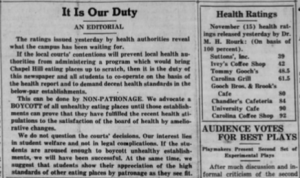
“It Is Our Duty: An Editorial.” Daily Tarheel (Chapel Hill, NC), Dec. 14, 1935. Courtesy of newspapers.com https://universityofnorthcarolinaatchapelhill.newspapers.com/image/67783858/?terms=it%2Bis%2Bour%2Bduty
This artifact is a Daily Tarheel article published on December 14, 1935. This editorial is on the front page of the newspaper, which was found on newspapers.com. It gives the sanitary ratings of eight Chapel Hill restaurants: Sutton’s, Ivey’s Coffee Shop, Tommy Gooch’s, Carolina Grill, Gooch Bros and Brook’s Café, Chandler’s Cafeteria, University Café, and Carolina Coffee Shop. A couple of the restaurants listed are actually still around today, like Carolina Coffee Shop and Sutton’s.
Carolina Coffee Shop was given the highest rating at 92/100, while Sutton’s was given the lowest rating at 39/100. To the left of the health ratings on the page, there is an editorial titled “It Is Our Duty.” The editorial suggests that students boycott the restaurants with below average health ratings, while giving their patronage to the restaurants with high ratings to show their appreciation. It states that the local courts will not allow health authorities to begin a program to increase the sanitary ratings of the Chapel Hill restaurants, so that it is the responsibility of the students to encourage the restaurants to increase their health ratings and sanitation.
This suggests that around this time period, the public and officials were starting to become more concerned with the quality and sanitation of restaurants. An article written by the Senior Sanitary Engineer for the U.S. Public Health Service in 1942 states that the Public Health Service began looking at restaurants in 1934. In December of 1935, the Public Health Service drafted An Ordinance Regulating Food and Drink Establishments. Later on in the article, in states that North Carolina was one of three states enforcing the regulations both state and local wide [1]. This shows that nationwide and specifically in North Carolina, around 1935-1940, there was growing concern about public health and restaurant sanitation. This is important to the Chapel Hill food story because the editorial and report published by the U.S. Public Health Service show that this is the time period in which customers and also public officials began to show more interest and concern in the sanitation of the local restaurants. This might not have been the case in earlier time periods because the U.S. Public Health Service had not developed a way to grade and inspect the restaurants [1.].
Works Cited:
- Fuchs, A. W. “The US Public Health Service Restaurant Sanitation Program.” American Journal of Public Health and the Nations Health 32, no. 8 (1942): 848-852.
By: Emma Kroll-Smith